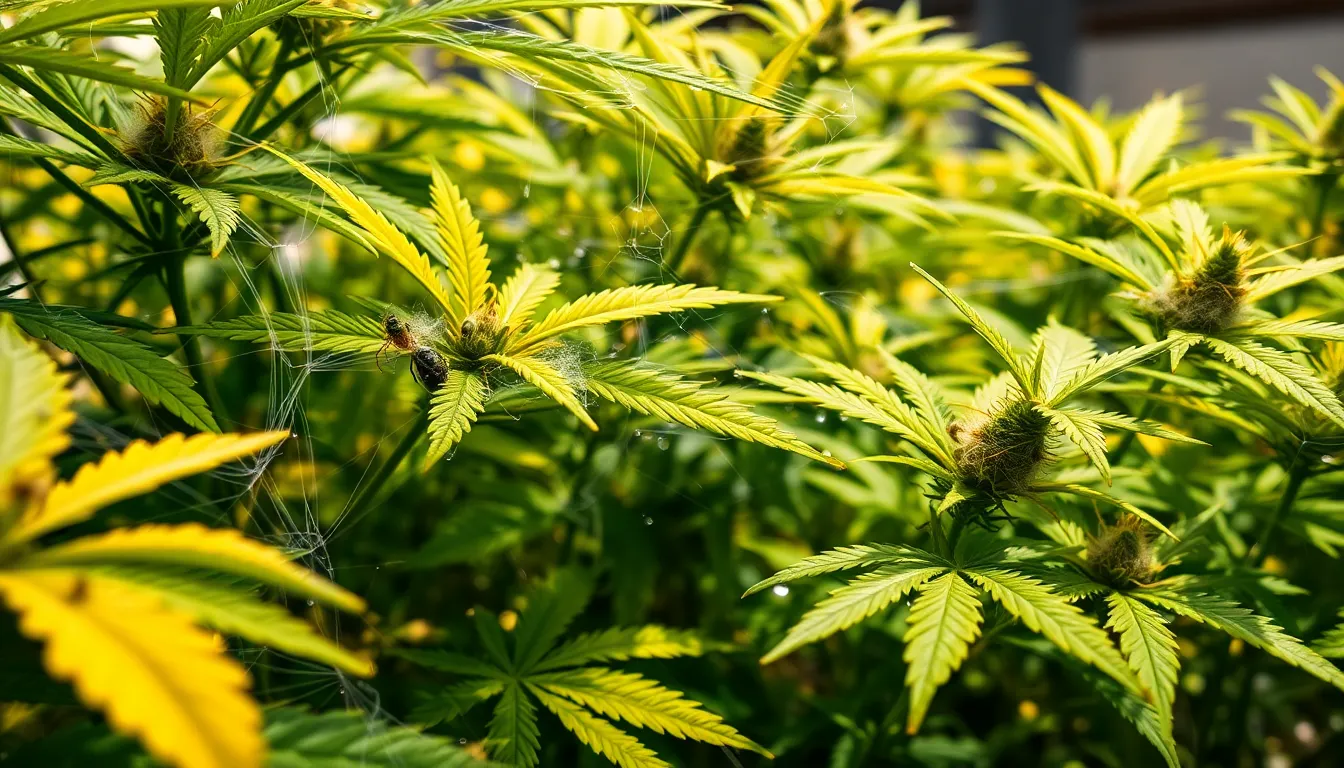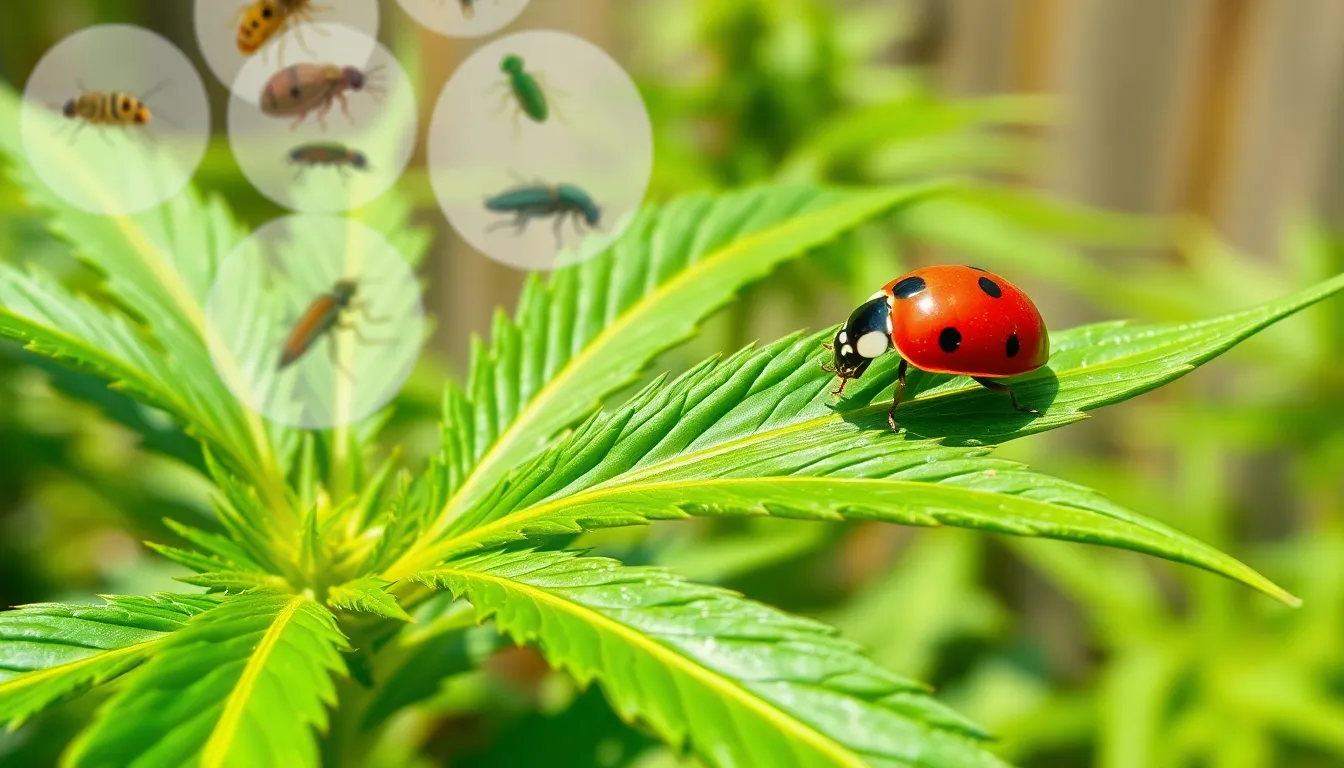Growing cannabis can feel like a walk in the park—until those pesky pests crash the party. Whether it’s spider mites throwing a rave on your leaves or aphids sneaking in like uninvited guests, these critters can turn a thriving garden into a disaster zone faster than you can say “bud.”
Cannabis Pests
Cannabis plants face various pest threats that can cause significant harm. Spider mites rank among the most notorious pests for cannabis growers due to their rapid reproduction and ability to damage leaves. Aphids also pose a problem, sucking sap from plants and potentially leading to stunted growth.
Common cannabis pests include:
- Whiteflies: These small insects disrupt photosynthesis by feeding on plant sap. Infestations can lead to a decrease in yields.
- Thrips: Known for causing scarring and discoloration of leaves, thrips can damage both young and mature plants.
- Fungus gnats: Life in the soil allows these pests to weaken young roots. Their larvae can cause root rot and hinder plant development.
- Leafhoppers: These pests transmit viruses and can lead to severe crop loss. They hop from plant to plant, making control challenging.
Each pest presents unique challenges. Infestations can escalate quickly if not addressed promptly. Moreover, the stress caused by these intruders can reduce overall plant vigor and yield. Identifying and monitoring common signs of pest presence is essential for effective management.
Cultivating healthy plants can help minimize the risk of pest infestations. Consider implementing integrated pest management strategies that combine cultural, biological, and chemical methods. Regular inspection and timely intervention play crucial roles in maintaining a thriving cannabis garden.
Common Types of Cannabis Pests

Identifying cannabis pests early can prevent significant damage to plants. Here are some common pests that growers encounter.
Spider Mites
Spider mites thrive in warm, dry conditions. These tiny arachnids often create fine webs on leaves, indicating their presence. Damage manifests as stippling or yellowing, resulting from their feeding on plant sap. A quick inspection can reveal these pests before they escalate. Keeping humidity levels adequate and utilizing beneficial predators like ladybugs helps manage spider mite populations effectively.
Aphids
Aphids come in various colors, often clustering on new growth. These soft-bodied insects feed on sap, which stunts plant growth and causes leaf curling. Their rapid reproduction leads to large populations in short timeframes. Growers can spot them by examining stems and undersides of leaves closely. Introducing natural predators, such as lacewings, or using insecticidal soap can control aphid infestations.
Whiteflies
Whiteflies appear as small, white moth-like insects that hover around plants. Their feeding weakens cannabis plants by extracting nutrients and sap. Affected leaves often turn yellow and may fall off. Regular monitoring reveals whitefly presence before infestations worsen. Maintaining plant health and employing yellow sticky traps are effective management strategies against these pests.
Fungus Gnats
Fungus gnats primarily target the roots of cannabis plants. Adult gnats lay eggs in moist soil, and larvae feed on roots, causing various growth issues. Signs of infestations include weakened plants and visible adult gnats flying near the soil. Allowing the top layer of soil to dry out between waterings can deter these pests. Using beneficial nematodes or insecticidal soil drenches aids in managing fungus gnat populations effectively.
Signs of Infestation
Monitoring cannabis plants for signs of pest infestation proves essential for maintaining healthy growth. Recognizing these symptoms early can prevent severe damage and loss.
Visual Indicators
Spider mites leave fine webbing on the lower leaves, causing stippling and yellowing. Aphid clusters appear on new growth, often leading to distorted leaves. Whiteflies may fly away when disturbed, and their presence often accompanies a sticky residue on leaves. Look for tiny, dark spots resulting from leafhoppers feeding on plant sap. Fungus gnats can also manifest through small adult flies around the soil. Each of these visual indicators serves as a warning signal for growers to act quickly.
Growth Impact
Pest infestations can hinder the growth of cannabis plants significantly. Aphids often stunt the new growth, leading to reduced yields. Spider mites can cause leaves to curl and drop prematurely. Whiteflies weaken plants by draining vital nutrients, weakening their overall health. Fungus gnats damage root systems, leading to poor nutrient uptake and stunted growth. Each pest type impacts the plant differently, emphasizing the need for vigilant monitoring and immediate intervention.
Prevention Strategies
Effective prevention strategies play a crucial role in protecting cannabis crops from pests. Growers can implement a mix of environmental controls, biological control methods, and chemical treatments for optimal results.
Environmental Controls
Creating a suitable growing environment minimizes pest attraction. Maintaining proper humidity levels deters spider mites, which thrive in dry conditions. Regular airflow through the grow area can decrease stagnant air, reducing the likelihood of infestations. Infection risk diminishes when plants receive adequate light, which promotes growth and strengthens defenses. Additionally, routine sanitation practices, such as cleaning tools and removing debris, help prevent pest proliferation.
Biological Control Methods
Utilizing natural predators provides a powerful tool for pest management. Ladybugs effectively control aphid populations, reducing their numbers significantly. Introducing predatory mites can combat spider mites in an eco-friendly manner. Beneficial nematodes target fungus gnat larvae in the soil, disrupting their lifecycle. By employing these biological methods, growers can maintain a balanced ecosystem within their gardens, decreasing reliance on harsher pesticides.
Chemical Treatments
In cases of severe infestations, chemical treatments become necessary. Insecticidal soaps target soft-bodied pests like aphids and provide a safer option for plants. Pyrethrin acts quickly against various pests, but must be applied carefully to minimize harm to beneficial insects. Systemic insecticides serve as an internal defense, offering lasting protection against persistent pest issues when used judiciously. Growers must follow guidelines to ensure effective and responsible chemical use, prioritizing plant health and safety.
Treatment and Management
Effective treatment and management of cannabis pests requires a multi-faceted approach. Growers need to act quickly to protect their plants.
Organic Solutions
Organic solutions often provide safe and effective pest management. Neem oil acts as a natural insect repellent, disrupting feeding and reproduction of pests. Introducing beneficial insects like ladybugs and lacewings can help control aphid populations. Garlic and pepper sprays serve as deterrents, masking plants’ scents and making them less appealing to some pests. Regularly inspecting plants ensures early detection of infestations, allowing for prompt treatment with organic methods.
Chemical Pesticides
Chemical pesticides offer another avenue for pest management when organic options prove insufficient. Insecticidal soaps are particularly effective against soft-bodied insects like aphids and spider mites. Systemic insecticides, absorbed by plants, provide longer-lasting protection by targeting pests that feed on treated foliage. Targeted applications reduce the risk of harming non-target organisms. Growers must follow application guidelines closely to maintain safety and effectiveness.
Integrated Pest Management (IPM)
Integrated Pest Management (IPM) combines various techniques to achieve sustainable pest control. Cultural practices, such as rotating crops and maintaining cleanliness, reduce pest habitats. Monitoring pest populations regularly allows growers to respond proactively. Biological control incorporates natural predators, enhancing ecosystem balance. Chemical options serve as a last resort, ensuring minimal environmental impact. This holistic approach not only addresses current pest issues but also helps prevent future outbreaks.
Conclusion
Managing cannabis pests is crucial for a successful harvest. By staying vigilant and recognizing the signs of infestation early, growers can take proactive steps to protect their plants. Implementing integrated pest management strategies not only helps in controlling current pest populations but also prevents future outbreaks.
Utilizing a combination of environmental controls, beneficial insects, and organic or chemical treatments ensures a balanced approach to pest management. Healthy plants are less susceptible to pests, so maintaining optimal growing conditions is essential. With the right knowledge and tools, growers can cultivate a thriving cannabis garden free from the threat of pests.

